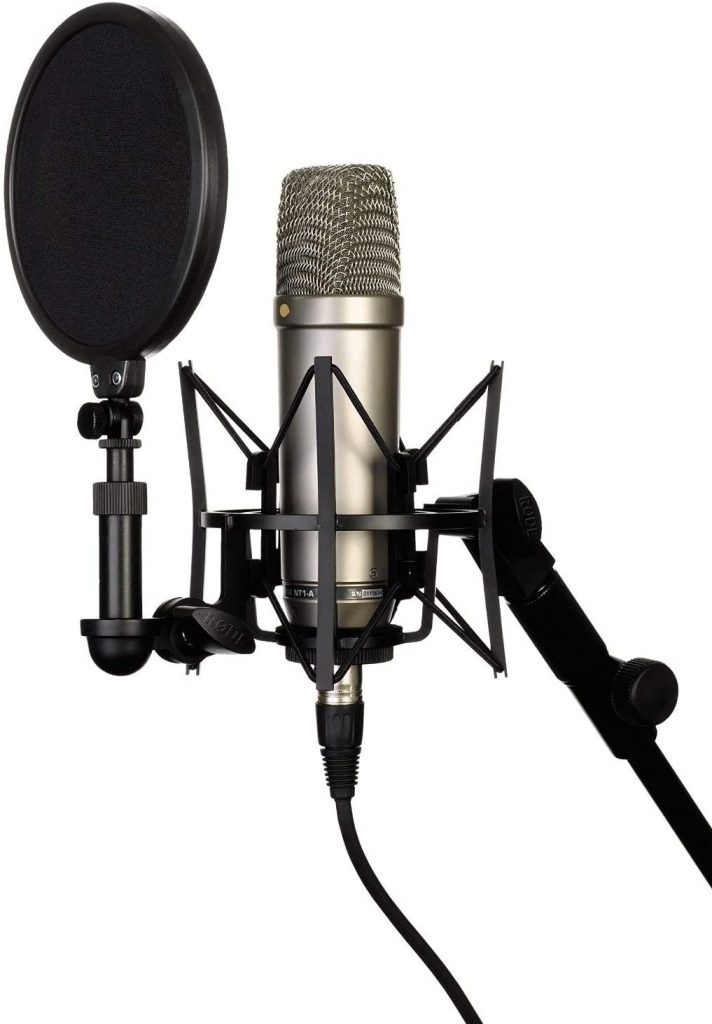Physical Address
304 North Cardinal St.
Dorchester Center, MA 02124


We’re passionate about music and our recommendations are genuine. If you buy through links on our site, we may earn a small affiliate commission at no extra cost to you.
Do you have a deep voice? If so, you know how difficult it can be to find the right microphone for your needs.
You may think that there isn’t much to choose from when looking for the best microphone for a deep voice, but this couldn’t be further from the truth. There are plenty of options, and they come at various price points too. Here we will look at some of these options and their pros and cons so that you can make an informed decision before making any purchases.
In this article, we’ll be going over the best microphones for recording deep voice and how they can help improve your tone of voice. So let’s get started!
There are quite a few reasons why this is important:
Of course, there are many other benefits too, but those three should give you an idea of how important this topic can be.
The Electro-Voice RE20 is one of the most popular microphones used by professionals of all kinds of voices. It has a smooth frequency range and avoids the proximity effect due to its variable diameter design. The RE20 was designed to combat the rising popularity of condenser microphones in film recording and broadcasting. Though initially created for use with those purposes, it quickly became a popular microphone used among broadcasters because of its superior sound quality compared to other types at that time.


The Electro-Voice RE20 is a high-quality microphone that has both premium aesthetics and durability. The metallic body of the mic gives it an expensive feel, while its large grill ensures this will stand out on stage. Its heavyweight adds to its sturdy design, making us think we could throw around without worry for damage or breaking.
The heavy-duty internal pop filter is one of the most impressive features of the Electro-Voice RE20. The integrated filter works really well, and we won’t recommend you buy any additional external filters.
The microphone also has an internal shock mounting system that works effectively without needing additional accessories or mounts outside the package provided. This prevents sound transmission through vibrations and shocks from occurring when recording.
The Electro-Voice RE20 is also a great gear to record brass instruments like trumpets, trombones etc.? Read our detailed guide here:
The Electro-Voice RE20 is a microphone designed for recording, broadcast, and sound reinforcement applications. It offers balanced frequency response across the entire range while maintaining excellent transient response comparable with condenser microphones.
The frequency response of the Electro-Voice RE20 is 45 Hz – 18 kHz. The mic’s frequency response has a solid low end below 400 Hz, with cuts at around 5 kHz and 18kHz. In addition, a bass tilt-down switch ensures performance quality when used at long reach or in other situations requiring additional attenuation on its bottom end frequencies.
The RE20 helps maintain the sound of the voice even if it moves off-axis slightly from the mic. This is because there isn’t an excessive bass boost as you get closer to this microphone and its Variable-D technology.
The microphone does not pick up feedback from monitors in a live setting. The cardioid pattern allows for placement only directly facing and rejects sound from 180 degrees off the axis.
The sensitivity rating of the RE20 is at 1.5 mV/Pa. It is a bit low. However, this can be attributed to its large Acoustalloy diaphragm and aluminum voice coil, both exceptional materials for sound capture.
If you’ve got a deep voice, the Electro-Voice RE20 is an excellent choice for your money. It’s bulky and expensive, but it delivers thick, rich sound with excellent neutrality, making this mic well worth its price tag.
Thanks to its rich, smooth sound and durability, the Shure SM7B is a dynamic microphone popular among broadcasters of all vocal types. The product of several decades of research into acoustics, the SM7B delivers an excellent tone even in less-than-ideal recording environments. Between this model’s extensive frequency response range and durable build quality, it makes for one sweet deal.


The Shure SM7B is a microphone with an eye-catchy design. It has an enameled aluminum and steel housing with a dark grey windscreen. It hangs from the integrated yoke, including a three-pin XLR jack and threaded nut for stand mounting. The rear of the mic sports some unique sound customization controls, including a visual representation of frequency spectrum and switches for low-frequency roll-off or mid boost frequencies.
The SM7B weighs in at about 1.5 pounds and has a circumference of 7 inches, making it difficult to handle without using a microphone stand with proper counterweighting capabilities. Even then, its integrated threaded nut is rather simple for mounting but can be easily overtightened when detaching the mic from stands.
The Shure SM7B microphone comes with one of the most delicate pop filters around. It is highly effective, regardless of how close you get to your mic when recording.
Overall the microphone has a pretty clean tone, but it does have some pronounced proximity effect. This means that when you’re off-axis or more than 2–3 inches away from the mic on-axis, there are fewer low frequencies picked up by the microphone. As with any other microphone, though, positioning is key, and if you get into your sweet spot, this provides a lovely rich sound.
The frequency response of the Shure SM7B is 50 – 20,000 Hz. This makes it an excellent microphone for professional users. They’ll be able to use it on vocals and instruments alike without any sound quality or clarity issues.
The Shure SM7B is a microphone that was designed to prevent any electromagnetic hum from ever happening. This is mainly due to its optimized shielding and internal shock mounting, ensuring no mechanical noise transmission.
Additionally, there is a bass roll-off filter that attenuates low-frequency notes like the hum of electrical gear. You can also use a presence boost which boosts mid and high frequencies.
The Shure SM7B is the cream of the crop. It’s one of those products that you can rely on for years, and it won’t let you down even if your life depended on it. The best part? They’re not cheap, but they are worth every cent.
The C214 condenser microphone by AKG is the perfect addition to your home studio, especially if you’re looking for a high-quality vocal or instrument recording. This mic has been seen in professional studios because of its ability to produce clear and crisp sounds that are essential during audio production.


The AKG Pro Audio C214 comes with an integrated capsule suspension that reduces mechanical noise and resonance to provide sonic accuracy. The all-metal diecast body provides RF immunity. In addition, the shock-resistant matte greyish blue finish protects the capsule from scratches or bumps.
Along with its fine features, the AKG C214 comes in a carrying case so that you can take it everywhere. It also has an anti-pop filter and a spider shock mount to make setup less of a hassle.
The AKG Pro Audio C214 is great for home studios and small-scale recording projects. It has an extremely clear, warm sound that will make your vocals stand out in the mix. This mic also works well with people who don’t speak very clearly on the mic or mumble a little. It’s not harsh like some of the other cheaper-end models. Still, instead, it accentuates your voice to give it more clarity and definition.
The frequency response of the AKG C214 is 20 Hz – 20 kHz. Its frequency rate is flat and rolls off the low-end very well. It has a natural response with its low pass filter on. It enhances voices but may not be to your liking according to personal preference. The C214 has a gentle attenuation that can still provide you with natural-sounding voices. In addition, its high-frequency gain at 15kHz makes them sound livelier.
The AKG pro audio C214 has a carefully crafted and smooth cardioid polar pattern. Its response rate is linear, but it still provides adequate coverage on the mic, making recording sessions smoother for you since there’s no need to worry about accidentally spoiling the quality of your voice recordings.
If you are looking for a microphone that will make your recordings sound professional, the AKG Pro Audio C214 is a perfect pick. It does well in most applications and has no glaring weaknesses. This mic’s bright but not harsh tone makes it versatile enough to use with different instruments or vocals types without changing any settings on your recorder.
The Audio Technica AT4033A is the perfect condenser microphone for all vocals, especially deep or unclear vocals. In addition, it has a solid up-front presence that makes it great for recording vocals and instruments. This classic cardioid studio condenser has been used in countless studios around the world since its release.


The Audio Technica AT4033A condenser microphone is a side-address, large-diaphragm instrument mic with a transformerless design. In addition, it features a precision-machined nickel-plated brass acoustic element baffle that provides enhanced element stability and optimal sensitivity.
The 2-micron-thick, vapor-deposited gold diaphragm undergoes a five-step aging process so that the optimum characteristics achieved remain constant over years of use. In addition, the classic shock mount provides superb noise isolation.
Audio Technica AT4033A microphone includes a shock mount, dust cover, and smooth black carrying case that protects the device while you are transporting it.
The Audio Technica AT4033A is designed to capture the warmth of a deep voice. The large, open‑basket design provides excellent sound rejection from off‑axis sources for high gain before feedback in live performance settings. In addition, the microphone’s frequency response and transient response are tailored to the human voice, and it exhibits an extended low-frequency range with a minimal proximity effect.
The frequency response of the Audio Technica AT4033A ranges from 30Hz-20kHz. It has a roll-off between 25Hz and 200 Hz that creates some light bums at the high end. The sound is immaculate throughout, with no added coloration to speak of.
The Audio Technica AT4033A microphone has the standard cardioid recording pattern, which is excellent for recording vocals.
The Audio Technica AT4033a is an excellent microphone for deep vocals. It’s not the best condenser mic out there, but it does its job well in most studio settings. It has good isolation capability and would work well in confined spaces. We believe it’s worth the price because of its reliability, shock stand included, and quality sound.
The Rode NT1-A cardioid condenser microphone is a well-designed, affordable mic that delivers the warmth and clarity needed for vocals and many other applications. It’s perfect for deep voices that do not pick up breathing or mouth noises as some microphones do.


The build quality of the Rode NT1 leaves nothing to be desired – its body is made out of machined aluminum nickel-plated to prevent corrosion or scratches. In addition, its internal components are protected by a military-grade ceramic coating that makes them resistant against moisture and dust. This makes the mic virtually indestructible.
The Rode NT1 comes with a shock mount that attaches directly to your desk or table, so you don’t need to worry about finding somewhere safe to put your mic while you’re recording. This also helps keep unwanted vibrations from being picked up when using this microphone, resulting in much clearer audio files overall. In addition, you’ll never have another issue with background noises like typing or chair squeaks again.
The NT1 microphone for vocals is perfect because it has a crisp and detailed mid-range with plenty of warmness in the lows.
The frequency response of the Rode NT1-A is 20 Hz – 20 kHz. The highs are airy but not too harsh. It also comes with an unobtrusive double mesh pop shield that works well to filter out unwanted pops or hisses when singing into the mic.
It’s super sensitive with only 5dB of self-noise, which means it won’t interfere with your recordings like other mics might. It also has a nice flat frequency response that hovers around the 0 dB mark and can record instruments.
The Rode NT1-A is a cardioid microphone. This type of mic has an ideal polar pattern for recording vocals because it won’t pick up any noise from behind the mic, reducing background noise in your final recordings.
The NT1-A is an excellent all-around condenser mic, perfect for getting a crisp, pristine sound when recording acoustic guitars. It can also be used for vocals with a deep voice. This Rode microphone is the one you need if your main concern in music production is capturing detailed sounds that are accurate and pleasing to listen to.
Choosing the right microphone for a deep voice can be confusing and tricky.
The key to choosing the right microphone is not just about the price but also finding one that suits your voice. It’s easy to get confused by all of the options available on the market today, and it can be hard to know where to start when looking for a new mic. You need something that will do justice to your talent, but you don’t want to spend more than you have to.
The right microphone can make all the difference when it comes to your voice. If you’re not using the right mic, no matter how good your voice is, it won’t shine through.
The following factors need to be considered during picking up a microphone for a deep or bassy voice.
When choosing a mic, make sure it has plug-and-play capabilities so that you don’t have any issues while using it and won’t waste time trying to figure out how everything works together. It should also be compatible with your computer system and other devices for everything to run smoothly when recording audio files or podcasts online. That way, you’ll always be able to capture great sound every time.
The microphone’s frequency response is one of the most important factors in recording quality. It determines how well a microphone captures the sound and can make or break your recordings. If you want to get the best possible recording, it’s crucial that you understand what this means for your next purchase. The usual frequency response of humans are:
You need to consider these ranges before buying a new microphone based on your need.
Knowing which type of directional pattern is best for voice-over work will help you avoid ambient noise and room resonance that could ruin your recording. If this makes sense, then a cardioid or hyper-cardioid would be the polar pattern to look out for as these are designed to pick up sounds within close proximity of the front side.
Durability is key when choosing a microphone, especially if you plan on using it often in the future. If it breaks easily, then there goes all that money down the drain. We recommend buying a microphone built with metal/diecast metal. This will ensure longevity and durability, although they may be a bit heavier.
You can achieve a more professional-sounding recording with the use of a pop filter. A pop filter is an essential tool for any voice actor, and it’s also very easy to set up. It will help you get rid of those pesky plosives that make your recordings sound amateurish and unprofessional. Choose a microphone that comes with an integrated decent pop filter to serve this purpose for you.
The shock mount is an important part of your microphone. It suspends the mic by elastics, isolating it from stand vibrations and low rumbling underfoot. For instance, if there is a low rumbling underfoot, the shock mount can absorb it. This will help you to get better sound quality when recording voice or podcasting, for example. Many mics come with shock mounts. Remember to choose them out of many options out there.
When it comes to finding the best microphone for your voice, you want to make sure that what you’re using is affordable and works well. The quality of a good mic should be considered a nice extra but not necessarily required when investing in one.
With a little research and a lot of consideration, you will be able to find the best microphone for a deep voice. We hope the article has given you some useful information about different microphones available on the market today. So it should be easy to make an informed decision when choosing one for yourself or someone in your family.